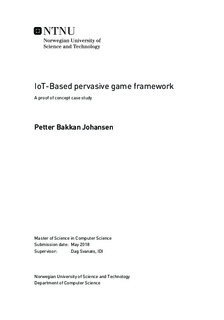| dc.description.abstract | With the Internet of Things (IoT) playing a key role in the Fourth Industrial Revolution
it is clear that it will become a larger part of our day to day life. IoT offers unique capabilities
for having tiny sensors and embedded systems take part in the Internet and
expand the way we use the Internet today. Researchers are currently researching the
benefits of utilizing playful digital technology to encourage health promoting activities
for both children, adolescents, and elderly, and pervasive games have shown promising
signs both for reducing sedentary behavior and as tool for rehabilitation for elderly
stroke victims. The combination of pervasive games and IoT is at the time of writing
a fairly unexplored field of research and the research done in this paper seeks to help
establish the state of the art and provide a framework that could help drive the research
forward.
In this master thesis, a framework for prototyping and developing pervasive games
that utilize Internet of Things was developed and evaluated in a proof-of-concept manner.
The evaluation was done with a proposed technology stack that included a Raspberry
Pi Zero W, several RFduinos, the Bluetooth Low Energy and Wi-Fi protocols, the
MQTT protocol, and the Unity game engine. The chosen technologies were based on
a list of requirements that were proposed as suited features for supporting prototyping
and development of IoT-based pervasive games. The list of requirements were established
based on a state of the art presentation on IoT, Cloud technology, pervasive
games, and exergames.
The proof-of-concept evaluation was based around a case study with the game
Follow the Red Dot , a simple pervasive game where a dot is transfered between
different devices when players interact with the device that is currently in control of
the dot. Follow the Red Dot was chosen as the case as its structure allows for implementations
in both local and distributed settings, in addition to supporting a virtual
mirroring of the active game devices. The case study was split into three different cases
to provide insights into different attributes of the technologies that were evaluated.
The results showed that the technology stack satisfied all the requirements that
were initially set for technologies. The framework developed also provided the intended
functionality when integrated with the suggested stack. There were however
some issues experienced with the RFduinos and the discussion suggests that there
likely exists better alternatives that would provide the same functionality, but in more
reliable fashion. The results also brings forth that developing a stack that is suited
for every type of IoT-based pervasive games isn t really feasible as the pervasive game
genre includes so many different sub-genres that vary in architecture, interaction, and
potential IoT usage. The research finally proposes that wider and more specific research
should be performed on the different technologies that exists within each of the
layers, as the limitations of this thesis restricted the amount of research done on the
different technologies. | |

